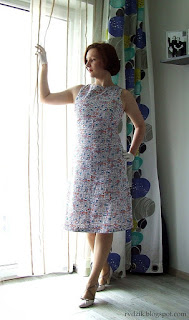Today's post is rather a shortie and stars
Renée as the graceful model. Some time ago (oh my, 2 years to be precise) one lady from my family had heard about the fact I'm sewing and she approached me with a request. In general I don't grant "would sew me this or that" favors, but there were 3 things that made the situation different that time:
1) the lady had a fabric that we both loved
2) she has waited patiently for me to sew the dress for 2 years without as much as a word of hurrying me up
3) she wanted to have a dress like the ones worn in her youth, that is the late 60s. She sighed, looked at the clothes in her closet and said "They just don't make it anymore the way they used to in the 1960s, you know".
The trick was that she only had a 140cm (about 1,5 yards) of the fabric. I chose Simplicity 1609, a 60s repro, because if the iconic and clearly defined A-line of the dress and clever shaping with only 4 main pieces, but the pattern called for at least 170cm of fabric.
That is why, my dear Readers, the print is awfully mismatched at the seams.
Have mercy.
My camera had a terrible problem with focus when photographing that print.
On the pattern cover model the dress is just above the knee, but since the future owner of this cotton frock looks her best in something just-below-the-knee, I lenghtened it by a few centimeters. I loved how the combination of bust darts and french darts shape the bodice. The lady I sewed for is big busted, so I had to modify the pattern a little bit. Aside from FBA it's a good thing to keep in mind that shortening and rounding the bust darts is a quick and simple way to flatter the D+ cups (I think I've read it somewhere in Threads). The fabric was pure fun to sew with-a dense, cheerfully printed seersucker cotton. Beause of the yardage shortage, I made the facings out of white cotton poplin from my stash. All the seam allowances are pinked and topstitched.

I changed the fastening- instead of a long back zipper I made a small opening at the neck with a tiny button and a loop made of a strip os bias-cut self-fabric with the stretch steamed out of it. There is no prolem to get in and out of the dress.
As you can see in the photo above, I also made a small string-like belt to help with accentuating the waist.
The back...
...and the insides
Because I had so little fabric, I hemmed it with a help of white satin bias ribbon, hand stitched (as always) to avoid marking the fabric from the outside.
I won't model the dress as it's not my size, so I hope the mannequin photos will do for you. I'm off to pack the dress as a gift :-)
























































